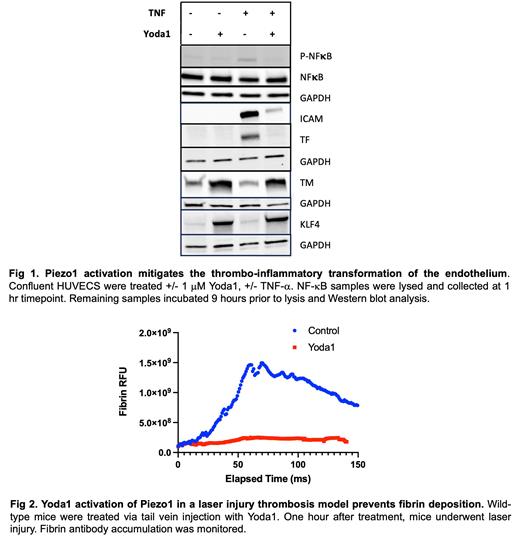During severe inflammatory states, the endothelium undergoes a transformation from an anticoagulant to a prothrombotic surface. The prothrombotic state is potentiated at sites of pathologic mechanical stimulation: stasis or pathologically low shear forces associated with inflammation, high shear forces associated with vascular shunt, or disturbed flow associated with stenosis. Mechano-sensing ion channels have profound effects on endothelial phenotypes. However, whether they control the prothrombotic transformation of endothelium is unknown. Our premise is that endothelial mechano-sensing channels function in thrombosis formation and that targeting these channels will interfere with thrombosis. We therefore determined how modulation of Piezo1, the most abundant (by RNA quantification) endothelial mechano-sensing Ca 2+ channel, affected endothelial prothrombotic responses to inflammatory stimulants. Incubation of human umbilical vein endothelial cells (HUVECs) or human microvascular endothelial cells of lung origin (HMVECS-L) with the Piezo1 agonist Yoda1 reduced TNFα-mediated factor Xa (FXa) generation by 79% (p< 0.001) and 85% (p< 0.001), respectively. Yoda1-mediated protection was reversed by siRNA-induced knockdown of Piezo1, confirming the protective effect was specifically mediated by this channel. Jedi1, a second Piezo1 agonist, was also protective. The protective effect was generalizable to other inflammatory stimulants since Piezo1 stimulation significantly (p<0.001) reduced thrombin generation in response to LPS (95% reduction), TNFα (99% reduction), and poly(I:C) (76% reduction) and significantly (p<0.001) reduced FXa generation in response to LPS (78% reduction) and poly(I:C) (69% reduction). Piezo1 activation was effective in reducing FXa generation when stimulated either 6 hours before or one hour after inflammatory stimuli. To understand the mechanism by which Piezo1 activation protects against the prothrombotic transformation of the endothelium, we evaluated endothelial Ca 2+transients under our experimental conditions. Unexpectedly, TNFα exposure totally abolished basal Ca 2+ oscillation that were observed in untreated cells. Piezo1 stimulation by Yoda1 rescued these Ca 2+ transients. This result indicated that recovery of basal Ca 2+ flux normalizes endothelial function. To better understand the downstream implications of these changes in Ca 2+ flux, we evaluated Yoda1's effects on endothelial transcription factors and the prothrombotic machinery. Evaluation of the flow-sensitive transcription factor KLF4 showed increased expression with Yoda1 exposure (7-fold, p<0.01). Knockdown of either KLF2 or KLF4 reversed the protective effect of Yoda1 on TNFα-induced FXa generation, confirming the role of these transcription factors. Piezo1 activation inhibited TNFα-induced NF-κB phosphorylation (67% reduction, p<0.001), tissue factor expression (99% reduction, p<0.0001) and ICAM expression (96% reduction, p<0.05) (Fig. 1). In contrast, thrombomodulin expression was increased to 2.8-fold (p<0.001) of control. To investigate the in vivo impact of pharmacologic activation of Piezo1 on thrombosis we utilized an intravital murine laser injury model. Yoda1 or vehicle was delivered via tail vein injection into wild type mice followed by laser injury to a cremaster arteriole. In the setting of Yoda1 Piezo1 activation, we observed decreased endothelial-associated fibrin antibody accumulation (71% reduction, p< 0.01) in response to laser injury (Fig. 2). Taken together, our results are consistent with a model in which Piezo1-mediated rescue of basal Ca 2+ oscillation enhances transcriptional activation of KLF2/4 resulting in decreased activation of NF-κB, reduction of tissue factor, enhancement of thrombomodulin expression, and decreased fibrin generation. These observations form the basis for a new strategy of controlling the thrombosis of inflammation by restoring endothelial Ca 2+ transients through stimulation of Piezo1.
Disclosures
MacRae:AstraZeneca: Research Funding; Quest Diagnostics: Research Funding; Verily Life Sciences: Research Funding; Merck: Research Funding; Sanofi: Research Funding; Novartis: Research Funding. Flaumenhaft:Versiti Blood Research Center: Membership on an entity's Board of Directors or advisory committees; Porosome Therapeutics: Current equity holder in private company, Membership on an entity's Board of Directors or advisory committees; Cleveland KUH- Training network: Honoraria, Membership on an entity's Board of Directors or advisory committees; Function Therapeutics: Membership on an entity's Board of Directors or advisory committees; Platelet Diagnostics: Consultancy, Current equity holder in private company, Patents & Royalties; Xap Therapeutics: Consultancy.


